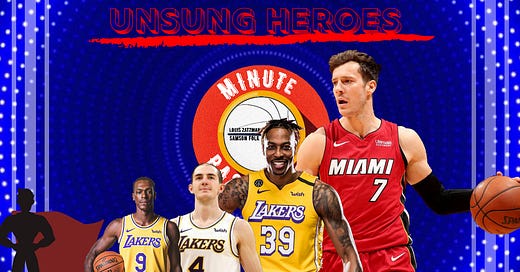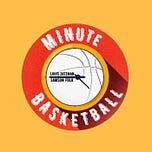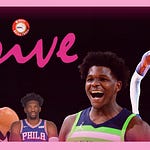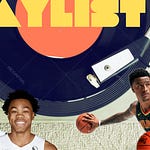
Unsung Heroes instill in us the belief that ordinary people can be agents of change. They provide us with reference points and road maps to accomplishments that are larger in scope than we might have imagined. We're all spectacular in that way. The heroes of our own story, and unsung in the stories of others. This week in Minute Basketball, we're showing love to the Finals participants who didn't get enough love on the way up.
Zatzman

The rest of the Lakers
What’s a song to the most storied franchise in the NBA? A song can be made to mean little, a throwaway price -- it’ll only cost you a song and a dance. That’s how the Lakers view love and affection. The Hollywood Lakers have an embarrassment of riches of adoration. Even the most unsung Lakers have vast amounts more press than better players in smaller markets. Entire marketing industries built around their glorification.
So how can a Laker be unsung?
It’s a fair question. But when you look at the details, zoom in to the Lakers’ reality on the ground, you see a more complicated picture.
LeBron James and Anthony Davis are as celebrated as two players in the NBA could be. For good reason, particularly after watching them dismantle the Miami Heat in game one of the Finals. This is not a diatribe to salute or scorn the big two, but instead about the other guys. They only exist in the framework created by James and Davis. James is the NBA’s definition of the Sun King. L’état c’est moi (lui, I suppose).
Where does that leave the other guys? Rightly or wrongly, they live to serve, unsung in the wins and condemned in the losses. That’s always been true of teammates of James. But these ones deserve their flowers. Let’s sing a song to their acclaim, win or lose. Probably win.
Dwight Howard is a surefire Hall of Famer. It’s a little bizarre that a player of his ilk can’t even average 20 minutes a game on the top-heavy Lakers. But age and injuries have harvested a toll on Howard, and he’s not the player he was once. But he remains a defensive plus in certain situations, and he’s game to wrestle with anyone. Anyone includes the Herculean Bam Adebayo this round, so Howard deserves some respect for that alone.
The Lakers are worse with Howard at center rather than Davis, but Howard dunks lobs, chases rebounds, and tosses fouls around like candy. It’s hard for Hall of Famers to accept that role. Howard didn’t for half a decade, even though it would have benefited him. His last tenure in Los Angeles was a disaster for that very reason. Yet Howard has accepted it now. He’s a small positive, but that’s what championship teams need: small positives across the roster.
For his part, Rajon Rondo has been one of the most confounding players of the 2020 playoffs. Long derided by the analytical crowd -- myself included -- as a huge negative because of his lack of shooting and defensive freestyling, he’s had some massive games for the Lakers. People begrudgingly admit that his basketball IQ (an ethereal concept, sure) is off the charts, yet that hasn’t manifested in him actually helping a basketball team for a long time; he hasn’t had a regular season with a positive on-off net rating since 2011-2012. Yet playoff Rondo seems to have once again come to roost. (It helps when you shoot over 40 percent from deep, even if his attempts are disrespectfully open shots.)
But Rondo’s creative passing helps the Lakers when their enormous size clutters the offensive end, and his nifty arsenal of scoops are a solid late-clock bailout. He played connector in game one against Miami from the middle of the zone. Rondo hasn’t gone a single playoff game without attempting a triple, and he’s made one in every game but one. His usage rate goes up to nearly 21 percent when James is off the floor. Rondo has emerged, for the first time in years, as a useful rotation piece. Who knows if that will continue when his hot shooting streak ends, but those are lyrics for another song.
That leaves us with the most complicated celebrity in all of basketball: Alex Caruso. If you listen to a random TNT broadcast on any given evening, you may mistake him for Larry Bird, Gary Payton, Dominique Wilkens. The myth of Caruso’s greatness is spread by broadcasters and even James himself, who calls Caruso GOAT, for greatest of all time.
They’re all in on the joke. White and balding, Caruso doesn’t look like an NBA player, let alone one who can rise up and dunk on most players. There are lots of people who take the joke seriously, who think Caruso is a star. He isn’t.
But the thing is, Caruso has actually been good! He’s one of four Lakers -- James, Davis, and Danny Green are the others -- to have positive on-off net ratings over these playoffs. Caruso’s defense is solid, and even though he’s shot poorly over the playoffs, he’s one of the few Lakers who can create for himself with the dribble. He can hit open jumpers, dribble, pass, and jump over help defenders. That’s enough to be a positive. His traditional numbers evoke a yawn, below Rondo’s over the playoffs in every category but blocks. But no matter the opponent, the Lakers are at their best with Caruso on the floor.
Does that make him Larry Bird? Not even a little bit. Caruso has plenty of songs sung about him. They’re just the wrong ones.
Folk

Super Gario
It’s strange really, how many teams let top-tier talent slip through their fingers. Russell Westbrook and Chris Paul have been at the forefront of the point guard conversation in the NBA for some time now. They both, famously, slotted in next to former MVP James Harden, with wide ranging potency. Two of the most impressive point guards of these playoffs also played for the Rockets in this decade - Kyle Lowry and Goran Dragic. Both with endless vitality and guile that prolongs their careers. In Lowry’s case, he’s carved out what should be a sure-fire HOF career with one of the greatest final acts we’ve ever seen from a point guard. In Dragic’s case, he’s recaptured his form from earlier in his career and is now the 3rd best player (and was all season, but a better version of himself now) on a team in the NBA Finals.
It’s fitting that a player who’s never been elevated to a true star’s role has found a place in a team that calls upon so many different players at different times in order to reach their greatest heights.
Heat Scoring Leaders By Round
RD1 - Dragic (22.8), Butler (19.8), Herro (16.5), Adebayo (15)
RD2 - Butler (23.4), Dragic (19.8), Adebayo (17.2), Herro (13.2)
RD3 - Adebayo (21.8), Dragic (20.5), Herro (19.2), Butler (19)
Playoffs - Dragic (20.9), Butler (20.7), Adebayo (18.5), Herro (16.5)
That’s right, Dragic is the leading scorer on an NBA Finals team. I won’t repeat it, but that sentence might need to be read a second time. So, why in the hell have we heard so little about him? I get it - Butler is a loveable leading man, Adebayo was the best player in an ECF (!!!), and Herro deserves his shine for a remarkable pick n’ roll game and a truly unique level of confidence. Dragic is at the heart of this thing, though. The Heat have been impressive defensively, of course, but it’s their ability to manufacture buckets that’s sustained them to this point. He’s in the 80th percentile in points per shot attempt at his position, and in the 92nd percentile at the rim - the Heat love that dependability.

How is Dragic doing this? Firstly, he has an undeniable slither to his game that few other players possess, and big men have never been able to figure out how to match his pacing. He herks and he jerks, embodying the herky-jerky guards who came before him, and he consistently makes fools of any team that switches a big onto him. Let him get a step on the guard and go 2-on-1 into the paint with Adebayo or Kelly Olynyk? You won’t like your chances either. He reads the game exceptionally well. The days of his career spent with Steve Nash aren’t just a fun anecdote, their shared time helped shape the rest of Dragic’s career and that’s evident anytime you see him ‘Nash’ the pick n’ roll, or walk a big man under his own basket before gently laying the ball in.

Nothing like a two-man game that isn’t afraid to improvise. These two play off each other beautifully, and it’s no wonder why Adebayo is shooting 67-percent from the floor on passes from Dragic.
Dragic has also worked really hard (#HeatCulture) to maintain his viability from downtown. The Heat run a heap of intelligent actions and they have a bunch of good decision makers to make the reads off of them. Dragic’s ability to space the floor not only allows his teammates more room to operate in, but it allows him an increasing number of angles to interpret his own offense with as a scorer or a passer.
The Heat don’t have Kawhi Leonard, Giannis Antetokounmpo or LeBron James. However (comma) they can put the ball in the hands of Adebayo in the high-post, run a split-action with Dragic and Duncan Robinson that flips into a DHO for Dragic, with Robinson spacing to the weak-side (and preventing anyone from tagging the rolling Adebayo) and oh look, a picture perfect lob for Adebayo! Clever plays for clever players, what a novel idea.

Dragic suits up next to the NBA’s true free throw and grift king, Jimmy Butler. Now, you might be thinking Butler ends up there all on his own, but he doesn’t. It’s not reflected in his free throw numbers, but Dragic has been putting opposing teams in foul trouble all postseason long. Few players get fouled on the floor more often than our pal ‘Super Gario’, and if you’ve seen (or see) the Heat in the bonus with 5 minutes left in a quarter, you should know that Dragic has already drawn two blocking fouls on big men that can’t hang with him.
The Heat succeed because there’s so much to watch out for when they’re on the court, and other teams get caught up or caught behind. Even though Dragic might not return to the NBA Finals (but here’s hoping), he deserves love for getting to this spot.
Stats are from Cleaning the Glass & NBA.com/stats
















Share this post